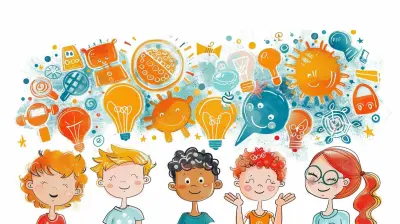Differentiated Instruction: Tailoring Lesson Plans for All Students
8 June 2025
Let’s be real—teaching a group of students with different learning styles, abilities, interests, and needs can feel like juggling flaming swords while riding a unicycle. One-size-fits-all lesson plans? Yeah, not cutting it anymore. That’s where differentiated instruction swoops in like a superhero with a backpack full of tailor-made teaching strategies. In this article, we’ll unpack why this approach matters, how to implement it, and what it actually looks like in a real classroom.

What is Differentiated Instruction Anyway?
Differentiated instruction is all about customizing teaching to meet the diverse needs of students. It's not about giving every student a totally different lesson; it's about tweaking content, process, products, or the learning environment based on students' readiness levels, interests, and learning profiles.Imagine hosting a dinner party for ten people—some are vegan, one has a peanut allergy, and another just hates tomatoes. You wouldn’t serve the same dish to everyone, right? Differentiated instruction does the same for the classroom—offering different "meals" so that everyone gets fed and feels comfortable.
Why It Matters More Than Ever
Today’s classrooms are more diverse than ever. Different cultures, languages, learning disabilities, and skill levels are all in one room. If we're serious about equity in education, personalization isn’t optional—it’s essential.Schools are shifting away from a "teach-to-the-middle" mentality and moving toward inclusive practices. Differentiated instruction supports this shift by making sure no student gets left behind—or bored out of their mind.

The Four Pillars of Differentiated Instruction
Let’s break it down. Differentiation typically happens in four main areas:1. Content – What Students Learn
This is about varying the material students are working with. While the learning goal remains the same, how students access that information can change. For example:- Some students may read a textbook chapter.
- Others might watch a short explainer video.
- A few may learn better from an infographic or even a hands-on demo.
It’s like teaching the same song but letting each student pick their instrument.
2. Process – How Students Learn
This refers to the activities and strategies used to help students make sense of the content. You might use:- Small group discussions
- Role-playing
- Interactive games
- Journaling or reflective writing
Giving students options on how to engage with the material keeps the process from becoming stale and serves a broader range of learning styles.
3. Product – How Students Demonstrate Learning
Everyone doesn’t have to show mastery in the same way. One student might create a video project, another could write an essay, and a third might design a poster. The key is aligning the product with both the learning objective and the student’s strengths.4. Learning Environment – The Physical and Emotional Climate
This covers everything from seating arrangements to classroom lighting to how safe and encouraged students feel to take risks. The goal? An environment where students feel respected, supported, and part of the learning community.
Know Your Students: The Foundation for Differentiation
You can’t tailor your lessons if you don’t know your audience. That means diving deep into:- Readiness – What do they already know?
- Interests – What engages them?
- Learning Profile – How do they learn best? (Visual, auditory, kinesthetic, etc.)
Consider using learning style surveys, interest inventories, and formative assessments regularly. Think of it like building a Spotify playlist—you've got to know your students' "music tastes" before you can compile the hits.

Strategies You Can Actually Use
Okay, so all of this sounds amazing in theory—but what does it look like when the rubber hits the road? Here are some go-to strategies to try.1. Tiered Assignments
Offer varied levels of difficulty for the same assignment. Think of it as offering beginner, intermediate, and advanced versions of the same concept. This is especially useful in mixed-ability classrooms.For example, in a math lesson on fractions:
- Group A works with visual manipulatives.
- Group B tackles word problems.
- Group C applies fractions to real-life scenarios like baking or budgeting.
2. Flexible Grouping
Mix it up regularly. Some days, group by interest. Other days, by ability or learning style. This keeps cliques at bay and encourages collaboration from different perspectives.3. Learning Stations or Centers
Create stations that explore the same concept in different ways. Students rotate through them to experience a mix of learning styles—something for everyone.Let’s say you're teaching ecosystems. One station has videos, another offers a hands-on model-building activity, and a third includes reading and discussion questions.
4. Choice Boards
Let students pick how they want to learn or show what they’ve learned. It's like a menu: they choose three tasks from a list—each represented by a different learning mode.Not only does this increase engagement, but it also builds autonomy and responsibility.
5. RAFT Strategy
RAFT stands for Role, Audience, Format, and Topic. It’s a creative way to push students to think from various perspectives. Here’s an example:- Role: A raindrop
- Audience: Elementary students
- Format: Children’s story
- Topic: The water cycle
Boom—science meets storytelling.
Differentiation in Action: Real Classroom Examples
Still feeling a bit fuzzy? No worries. Let’s paint a picture:Mrs. Lopez’s English Class
Reading Shakespeare can be a nightmare for some students. So Mrs. Lopez gives students options:- Read the play aloud in small groups.
- Watch a modern film adaptation.
- Use a graphic novel version.
- Follow an annotated guide with vocabulary hints.
Assessment? Students can write a character diary, perform a scene, or design a comic strip. Everyone hits the same learning standard, but they take different journeys to get there.
Mr. Patel’s Middle School Science Class
When teaching the water cycle, Mr. Patel uses learning stations:1. Multimedia Zone: Watch a video and complete a digital quiz.
2. Creative Corner: Build a model of the water cycle using everyday objects.
3. Reading Nook: Read an article and summarize it in a graphic organizer.
The result? Greater student engagement, deeper understanding—and way fewer glazed-over eyes.
Addressing Common Myths
Let’s bust a few myths while we’re here:- Differentiation is just more work for teachers. Initially, yes. But once the system is in place, it actually decreases stress by preventing disengagement and behavior issues.
- It’s only for struggling learners. Nope. High-achieving students need differentiation just as much to stay challenged and motivated.
- You have to create 30 different lesson plans. That’s wild. Differentiation is about strategy, not chaos.
Tech Tools That Make Differentiation Easier
We’re in the 21st century—let’s use it. Here are a few tools that can help:- Google Classroom – Assign variations of the same task to different students.
- Flipgrid – Great for students who prefer speaking over writing.
- Kahoot and Quizizz – Let you assess everyone in a fun, gamified way.
- Edpuzzle – Add interactive questions to videos for self-paced learning.
Challenges with Differentiated Instruction
No teaching strategy is perfect. Differentiation takes planning, flexibility, and time. You may also face:- Resistance from students who just want to blend in
- Pushback from parents who don’t understand the approach
- Time constraints (yep, still 24 hours in a day!)
But with practice and support, the benefits outweigh the bumps.
Tips for Getting Started
Feeling overwhelmed? Here’s how to ease into it:1. Start small – Pick one unit to differentiate.
2. Use what you already have – Modify existing materials instead of reinventing the wheel.
3. Collaborate with colleagues – Share strategies and resources.
4. Reflect and refine – What worked? What flopped? Adjust accordingly.
Final Thoughts: It’s All About Growth
At its core, differentiated instruction is about honoring where each student is on their learning journey. It’s not about lowering the bar—it’s about giving students the ladder they need to reach it. When you differentiate your teaching, you’re not just delivering content. You’re building confidence, sparking curiosity, and helping students realize their full potential.Isn’t that what teaching is all about?
all images in this post were generated using AI tools
Category:
Lesson PlansAuthor:

Eva Barker
Discussion
rate this article
2 comments
Ian Coleman
Differentiated instruction enhances student engagement and achievement by personalizing lesson plans to meet diverse learning needs and preferences effectively.
June 22, 2025 at 3:23 AM

Eva Barker
Thank you for your insightful comment! I completely agree—differentiated instruction is key to fostering engagement and success by addressing the unique needs of each learner.
Margaret Ross
Absolutely loved this article! Differentiated instruction is key to meeting diverse learning needs. Your insights on tailoring lesson plans will surely inspire educators to foster an inclusive classroom environment. Great job!
June 8, 2025 at 3:42 AM

Eva Barker
Thank you so much for your kind words! I'm glad you found the article insightful and helpful for fostering inclusivity in the classroom.


